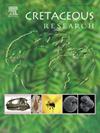中国西北下白垩世中生代裸子植物Xenoxylon Gothan的首次记录:对其全球古生物地理学的新认识
IF 1.7
3区 地球科学
Q1 GEOLOGY
引用次数: 0
摘要
在整个地球历史上,化石木材是了解陆地植被组成和重建大陆古地理的重要代表。著名的裸子植物木材,Xenoxylon Gothan,通常在北半球的中生代沉积物中发现。在中国东部地区约有80个本属植物。然而,迄今为止在中国西部中生代矿床中报道的产状有限。本文描述了甘肃玉门酒泉盆地下白垩统的新木材化石标本。该化石具有独特的Xenoxylon解剖特征,包括Xenoxylon放射状管状麻点和窗状交叉麻点。根据径向管胞坑、跨场坑和射线高度特征,鉴定为Xenoxylon meisteri Palibin et Jarmolenko化石。为了更好地了解中生代Xenoxylon的古生物地理,对其分布进行了全球调查,结果表明,从三叠纪到侏罗纪,Xenoxylon向高纬度和低纬度扩张,然后在白垩纪向北缩小其活动范围。本研究结果证实,xenoxylon型树木更有可能栖息在北半球高纬度地区(>30°N)。本文章由计算机程序翻译,如有差异,请以英文原文为准。
First record of the Mesozoic gymnosperm Xenoxylon Gothan in the Lower Cretaceous of northwestern China: New insights for its global paleobiogeography
Fossil wood serves as a crucial proxy for understanding terrestrial vegetation composition and reconstructing continental paleogeography throughout Earth’s history. The notable gymnosperm wood, Xenoxylon Gothan, is commonly found in the Mesozoic deposits across the Northern Hemisphere. In China, about 80 occurrences of this genus are documented in the eastern regions. However, limited occurrences are so far reported in the Mesozoic deposits of western China. Here, we describe new fossil wood specimens from the Lower Cretaceous of the Jiuquan Basin in Yumen City of Gansu Province, northwestern China. The fossils are characterized by the distinctive anatomy of Xenoxylon, including xenoxylean radial tracheid pitting and window-like cross-field pitting. Based on the characters of radial tracheid pits, cross-field pits, and ray heights, the fossils are recognized as Xenoxylon meisteri Palibin et Jarmolenko. To better understand the paleobiogeography of the Mesozoic Xenoxylon, a global survey of its occurrences is carried out, which reveals that Xenoxylon expanded its range both towards higher and lower latitudes from the Triassic to the Jurassic, then reduced its range northward in the Cretaceous. The results of this study corroborate that Xenoxylon-type trees were more likely to inhabit higher latitudes of the Northern Hemisphere (>30° N).
求助全文
通过发布文献求助,成功后即可免费获取论文全文。
去求助
来源期刊

Cretaceous Research
地学-地质学
CiteScore
4.10
自引率
19.00%
发文量
235
审稿时长
12 weeks
期刊介绍:
Cretaceous Research provides a forum for the rapid publication of research on all aspects of the Cretaceous Period, including its boundaries with the Jurassic and Palaeogene. Authoritative papers reporting detailed investigations of Cretaceous stratigraphy and palaeontology, studies of regional geology, and reviews of recently published books are complemented by short communications of significant new findings.
Papers submitted to Cretaceous Research should place the research in a broad context, with emphasis placed towards our better understanding of the Cretaceous, that are therefore of interest to the diverse, international readership of the journal. Full length papers that focus solely on a local theme or area will not be accepted for publication; authors of short communications are encouraged to discuss how their findings are of relevance to the Cretaceous on a broad scale.
Research Areas include:
• Regional geology
• Stratigraphy and palaeontology
• Palaeobiology
• Palaeobiogeography
• Palaeoceanography
• Palaeoclimatology
• Evolutionary Palaeoecology
• Geochronology
• Global events.
 求助内容:
求助内容: 应助结果提醒方式:
应助结果提醒方式:


